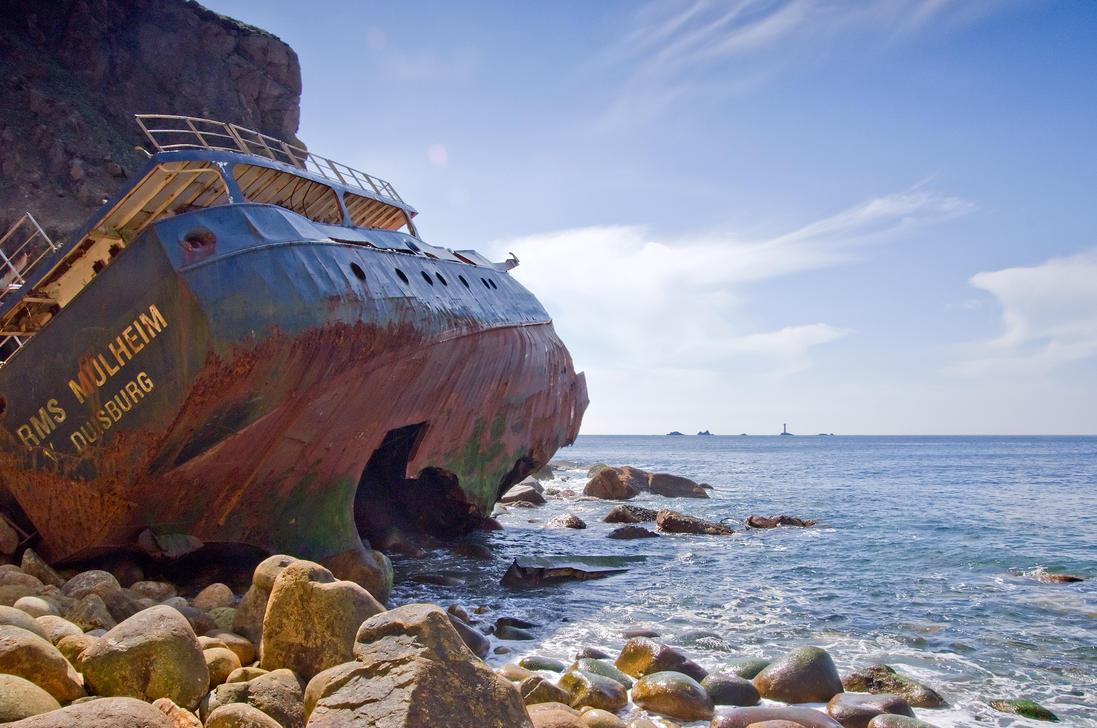RMS Mulheim
I am sure many of you will have seen this at some point at Lands End.
Back when she was a youngster:

On investigation, it was discovered that the chief officer, who had been on watch at the time, had caught his trousers in the lever of his chair when trying to get up, causing him to fall and rendering him unconscious. By the time he regained consciousness, RMS Mülheim was already bearing down on the shoreline.
There was diesel oil leaking into the ocean. The concerned agencies were informed, and a salvage operation was attempted. On 23 May 2003 RMS Mülheim was declared a constructive total loss. The salvage work was provided by the leading company Wijsmuiler Salvage. To remove as much cargo as possible, a conveyor belt system was used. When the weather and tide permitted, workers on the wreck filled jumbo-sized bags with the ship's cargo. Those bags were then brought up the cliff by the conveyor, which had been placed on the cliff just above the wreck. The operation ended on 29 May 2003. Although most of the cargo was removed, some was lost to the ocean. On 7 October 2003, in heavy seas, the ship was broken into two pieces. On 31 October 2003, the swells pushed the wreck of the RMS Mülheim into a rocky inlet called Castle Zawn. At that time the wreck was demolished down to its superstructure.
Back when she was a youngster:

On 22 March 2003, RMS Mülheim was on a voyage from Cork, Ireland to Lübeck, Germany, transporting 2,200 tonnes of scrap car plastic. The ship ran aground at approximately 0500 GMT in Gamper Bay, between Land's End and Sennen Cove, during which time there was "moderate visibility and fog patches".
On investigation, it was discovered that the chief officer, who had been on watch at the time, had caught his trousers in the lever of his chair when trying to get up, causing him to fall and rendering him unconscious. By the time he regained consciousness, RMS Mülheim was already bearing down on the shoreline.
There was diesel oil leaking into the ocean. The concerned agencies were informed, and a salvage operation was attempted. On 23 May 2003 RMS Mülheim was declared a constructive total loss. The salvage work was provided by the leading company Wijsmuiler Salvage. To remove as much cargo as possible, a conveyor belt system was used. When the weather and tide permitted, workers on the wreck filled jumbo-sized bags with the ship's cargo. Those bags were then brought up the cliff by the conveyor, which had been placed on the cliff just above the wreck. The operation ended on 29 May 2003. Although most of the cargo was removed, some was lost to the ocean. On 7 October 2003, in heavy seas, the ship was broken into two pieces. On 31 October 2003, the swells pushed the wreck of the RMS Mülheim into a rocky inlet called Castle Zawn. At that time the wreck was demolished down to its superstructure.





